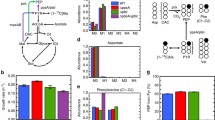Abstract
Different approaches to increasing carbon commitment to aromatic amino acid biosynthesis were compared in isogenic strains ofEscherichia coli. In a strain having a wild-type PEP: glucose phosphotransferase (PTS) system, inactivation of the genes encoding pyruvate kinase (pykA andpykF) resulted in a 3.4-fold increase in carbon flow to aromatic biosynthesis. In a strain already having increased carbon flow to aromatics by virtue of overexpression of thetktA gene (encoding transketolase), thepykA and/orpykF mutations had no effect. A PTS glucose+ mutant showed a 1.6-fold increase in carbon flow to aromatics compared to the PTS+ control strain. In the PTS− glucose+ host background, overexpression oftktA caused a further 3.7-fold increase in carbon flow, while inactivation ofpykA andpykF caused a 5.8-fold increase. When all of the variables tested (PTS− glucose+,pykA, pykF, and overexpressedtktA) were combined in a single strain, a 19.9-fold increase in carbon commitment to aromatic biosynthesis was achieved.
Similar content being viewed by others
References
Beckwith J. 1987. The lactose operon. In:Escherichia coli andSalmonella typhimurium. Cellular and Molecular Biology, Vol 2 (Neidhardt FC, JL Ingraham, KB Low, B Magasanik, M Schaechter and HE Umbarger, eds), pp 1444–1452, American Society for Microbiology, Washington, DC.
Berry A, S Battist, G Chotani, T Dodge, S Peck, S Power and W Weyler. 1995. Biosynthesis of indigo using recombinantE. coli: development of a biological system for the cost-effective production of a large volume chemical. In: Proceedings of the Second Biomass Conference of the Americas: Energy, Environment, Agriculture, and Industry, pp 1121–1129, National Renewable Energy Laboratory. Golden, Colorado.
Bolivar F, RL Rodriguez, PJ Greene, MC Betlach, HL Heyneker and HW Boyer. 1977. Construction and characterization of new cloning vehicles. II. A multipurpose cloning system. Gene 2: 95–113.
Chang ACY and SN Cohen. 1978. Construction and characterization of amplifiable multicopy DNA cloning vehicles derived from the P15A cryptic miniplasmid. J Bacteriol 134: 1141–1156.
Della-Cioppa G, SJ Garger, GG Sverlow, TH Turpen and LK Grill. 1990. Melanin production inEscherichia coli from a cloned tyrosinase gene. Bio/Technology 8: 634–638.
Draths KM, DL Pompliano, DL Conley, JW Frost, A Berry, GL Disbrow, RJ Staversky and JC Lievense. 1992. Biocatalytic synthesis of aromatics fromd-glucose: the role of transketolase. J Am Chem Soc 114: 3956–3962.
Draths KM, TL Ward and JW Frost. 1992. Biocatalysis and nineteenth century organic chemistry: conversion ofd-glucose into quinoid organics. J Am Chem Soc 114: 9725–9726.
Ensley BD, BJ Ratzkin, TD Osslund, MJ Simon, LP Wackett and DT Gibson. 1983. Expression of naphthalene oxidation genes inEscherichia coli results in biosynthesis of indigo. Science 222: 167–169.
Flores N, J Xiao, A Berry, F Bolivar and F Valle. 1996. Pathway engineering for the production of aromatic compounds inEscherichia coli. Nature Biotechnol 14: 620–623.
Frost JW and JC Lievense. 1994. Prospects for biocatalytic synthesis of aromatics in the 21 st century. New J Chem 18: 341–348.
Gubler M, M Jetten, SH Lee and AJ Sinskey. 1994. Cloning of the pyruvate kinase gene (pyk) ofCorynebacterium glutamicum and sitespecific inactivation ofpyk in a lysine-producingCorynebacterium lactofermentum strain. Appl Environ Microbiol 60: 2494–2500.
Lerner CG and M Inouye. 1990. Low copy number plasmids for regulated low-level expression of cloned genes inEscherichia coli with blue/white insert screening capability. Nucl Acids Res 18: 4631.
Mascarenhas D, DJ Ashworth and CS Chen. 1991. Deletion ofpgi alters tryptophan biosynthesis in a genetically engineered strain ofEscherichia coli. Appl Environ Microbiol 57: 2995–2999.
Miller JE, KC Backman, MJ O'Conner and RT Hatch. 1987. Production of phenylalanine and organic acids by phosphoenolpyruvate carboxylase-deficient mutants ofEscherichia coli. J Ind Microbiol 2: 143–149.
Miller JM. 1992. Preparation and use of P1 vir lysates. In: A Short Course in Bacterial Genetics, pp 268–274, Cold Spring Harbor Laboratory, Cold Spring Harbor.
Patnaik R and JC Liao. 1994. Engineering ofEscherichia coli central metabolism for aromatic metabolite production with near theoretical yield. Appl Environ Microbiol 60: 3093–3098.
Patnaik R, WD Roof, RF Young and JC Liao. 1992. Stimulation of glucose catabolism inEscherichia coli by a potential futile cycle. J Bacteriol 174: 7527–7532.
Patnaik R, RG Spitzer and JC Liao. 1995. Pathway engineering for production of aromatics inExcherichia coli: confirmation of stoichiometric anlaysis by independent modulation of AroG, TktA, and Pps activities. Biotechnol Bioeng 46: 361–370.
Ponce E, N Flores, A Martinez, F Valle and F Bolivar. 1995. Cloning of the two pyruvate kinase isoenzyme structural genes fromEscherichia coli: the roles of these enzymes in pyruvate biosynthesis. J Bacteriol 177: 5719–5722.
Srinivasan PR and DB Sprinson. 1959. 2-keto-3-deoxy-d-arabo-heptonic acid 7-phosphate synthase. J Biol Chem 234: 716–722.
Wyman AR, LB Wolfe and D Botstein. 1985. Propagation of some human DNA sequences in bacteriophage λ vectors requires mutantE. coli hosts. Proc Natl Acad Sci 82: 2880–2884.
Yanisch-Perron C, J Vieira and J Messing. 1985. Improved M13 phage cloning vectors and host strains: nucleotide sequences of the M13mp18 and pUC19 vectors. Gene 33: 103–119.
Author information
Authors and Affiliations
Rights and permissions
About this article
Cite this article
Gosset, G., Yong-Xiao, J. & Berry, A. A direct comparison of approaches for increasing carbon flow to aromatic biosynthesis inEscherichia coli . Journal of Industrial Microbiology 17, 47–52 (1996). https://doi.org/10.1007/BF01570148
Received:
Accepted:
Issue Date:
DOI: https://doi.org/10.1007/BF01570148




